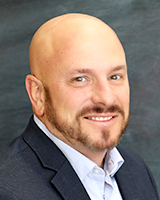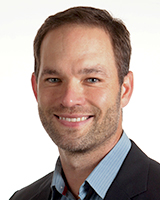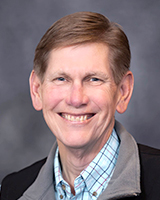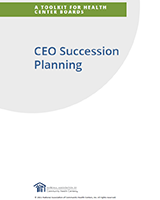Sep 11, 2024
Embracing the Inevitable: Succession Planning for Rural Healthcare Organizations
In 2020, the board of Horizon Health Care — a network of community health centers based in Howard, SD — found itself in uncharted territory. Their first and only CEO of 38 years had shared his retirement plans a few years earlier, and it was now time to begin the succession process.
Over the course of the following year — despite the board's inexperience and the disruptions of a global pandemic — the transition played out like clockwork. After running a standard search, Horizon's then-CFO Wade Erickson applied for and was offered the CEO position.

"I had worked closely with the outgoing CEO for 20 years, so that made the transition extremely smooth," said Erickson. Better yet, there was a 3-month overlap between Erickson's first day in April and his predecessor's official departure in July. This allowed time for introductions to key partners and for Erickson to fill the CFO position he had just vacated.
"I was very fortunate in the fact that my controller had worked for me for nine years, side by side, and was ready to step into that CFO position," said Erickson. He noted that a majority of his executive team have worked their way up gradually from within the organization. "They were able to build that knowledge and that passion and commitment to the mission long before they stepped into the executive seat," he said.
But not all rural healthcare organizations are so fortunate. And not all leadership transitions are so carefully planned and seamlessly executed.
For some, the departure of a top executive can lead to a mad scramble of emergency board meetings, long searches led by expensive third-party firms, strategic plans put on indefinite hold, the loss of institutional memory, and widespread uneasiness with ripple effects across the entire organization.
Many rural executives wear multiple hats. No one is doing just one job — so if you're losing them, lots of things come to a halt.
Leadership turnover is inevitable at any organization, but the effects may be more pronounced in rural areas. "Many rural executives wear multiple hats. No one is doing just one job — so if you're losing them, lots of things come to a halt," said Erin Sullivan, Associate Professor of Healthcare Administration at Suffolk University. She also noted that rural healthcare organizations may have a harder time absorbing the costs associated with a bumpy, drawn-out transition.
Sullivan is the lead author of a study on rural healthcare leader well-being published in July in The Journal of Rural Health. She and her colleagues found that, among 288 rural healthcare executives, "49.8% intended to leave their administrative roles within 2 years."
For John Henderson, President of the Texas Organization of Rural and Community Hospitals (TORCH) and a co-author of the study, that finding was something of a wake-up call. "I got scared," he said. "What we learned is that post-pandemic burnout rates are even higher than expected."
According to Henderson, the casual approach to succession planning within many rural healthcare organizations "was never enough." But after watching leadership turnover increase throughout the pandemic and after, he believes it should now be an even higher priority.
"I think even hospital leaders and board members would say that they haven't done enough," said Henderson. "It's just a matter of taking the time to do that intentionally."
The Fundamental Question
Succession planning means different things within different organizations. For some, it means a selective hiring process with an eye toward leadership potential. For others, it means cross-training the executive team and offering opportunities for mentorship and professional development.
But at the most basic level, a succession plan should answer the following question (framed in similar terms by multiple sources): If the CEO were to walk across the street this afternoon and get hit by a bus, who would fill in for them tomorrow morning?

Henderson suspects that most of the hospitals he works with in rural Texas don't have an answer. "We haven't polled them, but I'd bet any amount of money that 90% of my independent rural hospitals would be scrambling, and it'd be emergency board meetings and making a plan as you go," he said.
Ultimately, it is the responsibility of the board — not the CEO — to ensure that such a plan is in place, said Henderson. But fears of awkwardness or misinterpreted intentions could prevent some board chairs from raising the issue.
I think it's maybe a little bit of an uncomfortable conversation to have at a board meeting. They're used to the normal agenda.
"I think it's maybe a little bit of an uncomfortable conversation to have at a board meeting," said Henderson. "They're used to the normal agenda. To do succession planning in an organized way, it's just not common."
At Melissa Memorial Hospital in Holyoke, Colorado, establishing and reviewing a CEO succession plan has been part of the board's "normal agenda" for over a decade. According to board chair Steve Young, the policy was implemented on the recommendation of a governance training consultant.
Once a year, the board reviews the current CEO's plan for who would fill in — in an interim capacity — in the event of their sudden departure. Young says these plans have been put to use in real-world scenarios.

The details are flexible. "We've seen it vary a lot," said Young. "Sometimes there's just nobody within the facility that the CEO sees as the one that's going to step up. So it might be naming two or three people that can take parts and pieces of things if something were to happen."
Because the plan is discussed on a routine basis and required by established policy, Young doesn't worry about any misunderstandings on the part of the CEO. But he recommends clear communication from board chairs during the initial adoption process.
"You need to explain it so that your CEO understands that you're not trying to get rid of them, you're just trying to make sure that you have good leadership through transitions," said Young.
Henderson believes most CEOs would be receptive to such concerns. "The CEOs I know care a lot about their organizations," he said. "They want it to be okay — whether they leave because of a tragedy or another opportunity or drama with a physician. They want stability."

Resource Spotlight
The National Association of Community Health Centers' 2021 publication, CEO Succession Planning: A Toolkit for Health Center Boards, includes sample succession policies, customizable plans, and advice for implementation. While the toolkit is designed specifically for community health centers, much of the information is also applicable to other rural healthcare facilities, such as hospitals.
Growing Future Leaders
When Erickson accepted his first job at Horizon in his mid-20s, he didn't know much about healthcare — and he certainly couldn't have predicted that he would one day serve as the organization's CEO.
He studied accounting in college. "I never went to the doctor other than when my mom made me go as a kid, so I had to learn a lot," said Erickson. "I had to learn the difference between a CPT code and a diagnosis code."
Over time, as he developed expertise and saw the organization's impacts on local patients, what started as a job turned into a lifelong vocation. "It became a passion, and then it's like, okay, now I'm all in on this and still learning today," said Erickson. He credits regular opportunities for professional development — such as attendance at regional and national conferences — and years of mentorship from the previous CEO as key to his growth as a leader.
This kind of long-term investment in the development of young talent is another important aspect of many organizations' efforts to ensure the continuity of strong leadership. But there are no guarantees that the investment will pay off, as it did for Horizon. And rural organizations may find it particularly challenging to retain emerging leaders.
According to Young, his board would love to support more "succession from within" at Melissa Memorial Hospital. "But when you're in a town of 2,500, a lot of times that just doesn't work out real well," he said. "If they're qualified enough to become the CEO, they've probably already taken a job somewhere else."
We might not be developing somebody that's going to stay at Melissa Memorial, but maybe another hospital is developing somebody that will come to us.
That doesn't mean the effort was wasted. Young believes that when rural healthcare organizations invest in leadership development, everyone benefits. "We might not be developing somebody that's going to stay at Melissa Memorial, but maybe another hospital is developing somebody that will come to us," he said.
At Horizon, these efforts involve more than just identifying and developing possible future CEOs. For example, Erickson asks each of his executive team members to work within their departments to create a plan in the event of their unexpected absence. He also prioritizes cross-training within the executive team so that "everybody has the knowledge of what everybody else is doing."
"We know that if you lose one person in an organization that runs lean, it can break the whole system, or stall the system until you find a replacement," said Erickson. "So succession planning is for more than just the CEO. You have to have plans in place for every position, because they all play an integral part in what we do."
A Collaborative Approach
The Arkansas Rural Health Partnership (ARHP) is a nonprofit network of rural hospitals, community health centers, medical schools, and other partners seeking to improve rural healthcare across the state. Currently, ARHP offers interim financial management services to member organizations, which "often struggle to maintain a CFO or a controller," according to ARHP board president Brian Thomas.
ARHP is now seeking grant funding to expand this program to include interim CEO services. Thomas envisions "the partnership hiring a person or two to be available so that, when a hospital loses a CEO, there's somebody to step in immediately." He added that "among our 19 hospitals there is frequent CEO turnover, so you could rest assured that every year somebody in our network is going to be leaving a hospital."
Thomas believes this program could also serve as a launching pad for young professionals with an interest in healthcare leadership. He noted that there is strong interest in the program from local boards. If grant funding is secured, Thomas expects the program to be operational within 6 to 12 months.
Pipeline Problems
Efforts to grow future leaders "from within" often assume that talented, early-career employees are interested in continual advancement. However, Henderson and others shared concerns about a perceived decline in interest among young professionals in stepping up into leadership roles.
"I guess you could characterize that as a lack of ambition, but I think it's more just an awareness of the toll these positions can take," said Henderson. "It's a bunch of people saying, 'Regardless of pay, why would I sign up for that job?'"
Young attributed this shift to the increasing stressors and complexities of rural healthcare leadership. Over the three decades he has served on the Melissa Memorial Hospital board, he has watched the CEO role "mushroom into so much more that what it was 20 years ago."
The aforementioned Journal of Rural Health study sheds light on the particulars. Sullivan and her co-authors offer the following analysis of 122 comments from rural healthcare leaders on job-related stressors:
Comments revealed three broad dimensions of stress: (1) industry-level concerns (e.g. regulatory pressures, managing finances post-COVID, dealing with insurers), (2) daily operational challenges (e.g. wearing "multiple hats," hiring and retaining staff, inability to take a vacation, improvement projects), and (3) professional relationships (e.g. difficult relationships with board members, providers, and communities). The external pressure that leaders felt within their roles was notable, and directly related to their ability to survive in an increasingly difficult environment.
A survey response from a rural CEO offers additional insight:
It is usually the outside forces that create the stress not the internal team. It's the pressures of regulatory items, meetings, and always having to find a new innovative way just to keep the doors open on the hospital to provide medical care in our communities. We don't get to be innovative for fun, it's out of survival.

While many of these factors are outside the control of any individual organization, Sullivan encouraged boards to do what they can to support local leaders — from working to create a healthy board-CEO relationship, to allowing leaders to "craft roles that play to their strengths and the things they want to do every day."
"I'm starting to think a lot of this comes down to: How do we create organizations where people can thrive?" said Sullivan. "Because the challenges are real, but if we don't find a way to create organizations where people can thrive, we won't have people to work in these organizations and deliver care."
…if we don't find a way to create organizations where people can thrive, we won't have people to work in these organizations and deliver care.
Sullivan said she was slow to find collaborators for her research on healthcare leader well-being. "Potential partner organizations told me, 'They're making hundreds of thousands of dollars — so politically, we can't worry about them,'" said Sullivan. But she believes this perspective overlooks the impacts of stable leadership — or the lack thereof — on patient outcomes.
"At the end of the day in healthcare, this is about the patient," she said. "This is about delivering care for communities — and leaders do have an impact on that."
The Tyranny of the Urgent
Among all the factors preventing rural boards and CEOs from developing more robust succession plans, perhaps the most universal is what Sullivan termed "the tyranny of the urgent." With an endless stream of pressing issues competing for the attention of rural health leaders, it can be challenging to make time for less urgent, strategic initiatives like succession planning.
I don't have enough nurses to work on this unit — how can I worry about who's replacing me? I think I'm going to be here for five more years… right?
"It's like, 'I don't have enough nurses to work on this unit — how can I worry about who's replacing me? I think I'm going to be here for five more years… right?'" said Sullivan.
Henderson relates to this issue on a personal level. "I'll tell you that one of my goals for the year is to have a succession plan for myself, but I'll admit I haven't got to it yet," he said. "It's just always lower-priority and something else always comes up."
The unlikelihood that busy leaders will independently make time to craft their own succession plans is another reason why the process should ideally be led by boards and written into policy. However, some rural CEOs may need to initiate the conversation themselves if board members are not informed about the issue. And there are private reasons, beyond business, why they may choose to keep quiet.
"A rural CEO might think, 'If we do succession planning, I'll put the thought in their head of: Who's going to be after me? And once they start thinking about that, does it number my days here?'" said Henderson.
He hopes that succession planning will soon become so normalized and widespread among rural health organizations that these fears will seem ridiculous. "The shift we need is, this is not a fatalistic exercise, it's not opening the door to bad things happening," said Henderson. "It's just good governance."
